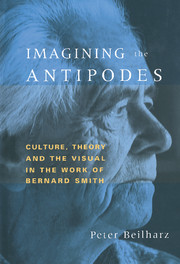Book contents
- Frontmatter
- Contents
- Preface
- Introduction
- Chapter 1 Beginnings
- Chapter 2 Encountering Australian Painting
- Chapter 3 Imaging the Pacific
- Chapter 4 The Antipodean Manifesto
- Chapter 5 Death of the Hero as Artist
- Chapter 6 Modernity, History and Postmodernity
- Chapter 7 Conclusions – Imagining the Antipodes
- Notes
- Index
Chapter 6 - Modernity, History and Postmodernity
Published online by Cambridge University Press: 22 September 2009
- Frontmatter
- Contents
- Preface
- Introduction
- Chapter 1 Beginnings
- Chapter 2 Encountering Australian Painting
- Chapter 3 Imaging the Pacific
- Chapter 4 The Antipodean Manifesto
- Chapter 5 Death of the Hero as Artist
- Chapter 6 Modernity, History and Postmodernity
- Chapter 7 Conclusions – Imagining the Antipodes
- Notes
- Index
Summary
DISTANCING THE MODERN
The more things change the more they stay the same. Or do they still? Debates continue endlessly regarding the question whether the substance of our lives is new, or whether we just recreate the old in new combinations and forms. Within a frame of thinking such as Bernard Smith's, the provisional conclusion on these matters is likely to be that our world is all of these things. On the one hand, we remain connected back to generations and centuries of activity seeking to hold life together, endeavouring to reproduce and maintain ourselves and our families. On the other, as Marx expressed it, after industrialism all that is solid melts into air. That line appears in The Communist Manifesto, a text which also has a certain stridency about it. It is not as though the world melts; Marx is telling us that it does melt, all around us. He borrows from precedents for the idea; the image can be found in the work of Carlyle, and more opaquely in Shakespeare. So perhaps even this idea about the new is not new. Moderns, in short, have to learn to live within paradox.
In Smith's thinking, as we have seen, civilisations recycle, recall, summon up archaic sensibilities or else borrow them from elsewhere, from other times or places; or they push forward in the collective imagination, into frames like those called futurism. Modernity, however, cannot generate its own meaning out of itself.
- Type
- Chapter
- Information
- Imagining the AntipodesCulture, Theory and the Visual in the Work of Bernard Smith, pp. 155 - 182Publisher: Cambridge University PressPrint publication year: 1997



